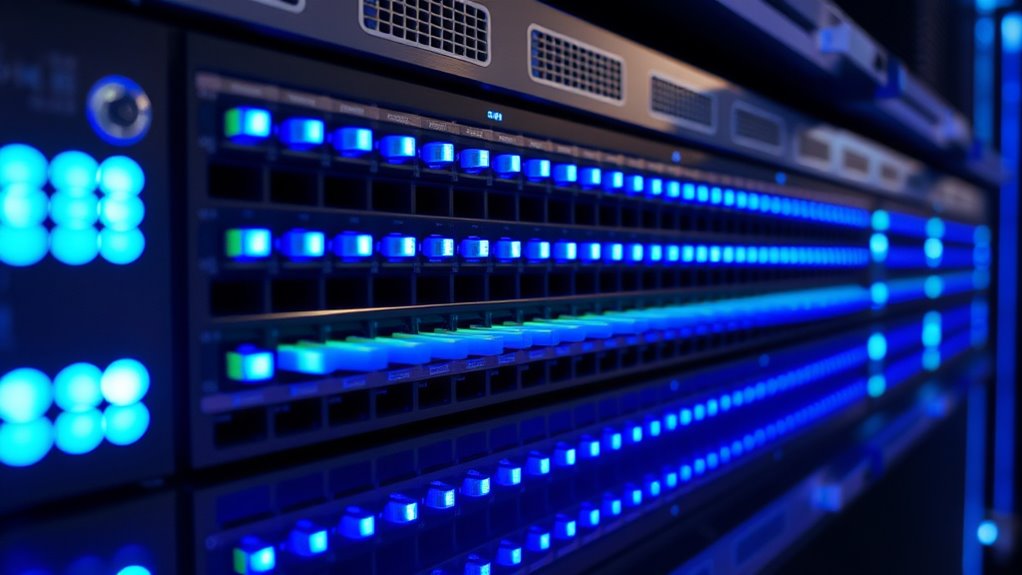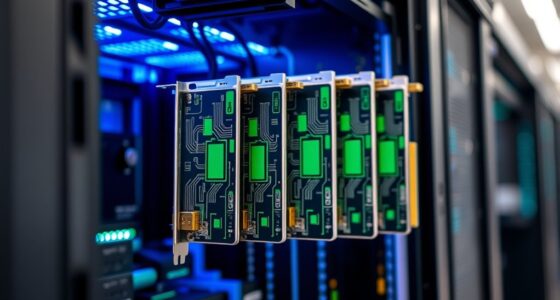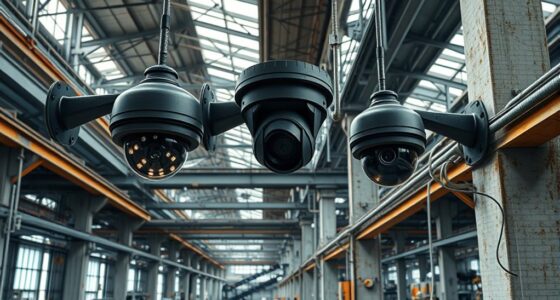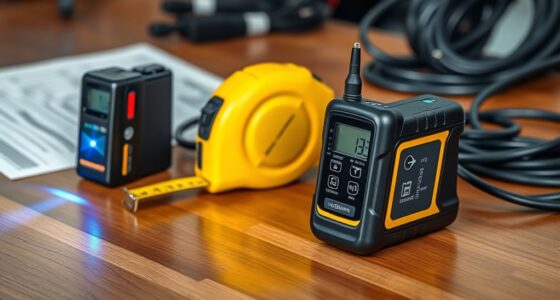When choosing the best fiber optic switches for backbone networks in 2025, I focus on durability, high performance, and environmental standards. Rugged switches with industrial-grade housing, redundancy, and certifications like IP67 are essential for harsh environments. I also look for switches with multiple fiber ports supporting long-distance links, managed features like VLAN and SNMP, and compatibility with various fiber types and modules. Keep exploring, and you’ll discover more key factors to guarantee reliable, seamless connectivity.
Key Takeaways
- Prioritize rugged, industrial-grade fiber switches with high IP ratings and temperature tolerance for outdoor and harsh environment backbone networks.
- Select switches supporting high-speed fiber ports (up to 10Gbps or higher) with long-distance SFP modules for extensive backbone coverage.
- Focus on managed switches with VLAN, QoS, SNMP, and redundant power features to ensure network reliability and flexible configuration.
- Choose compatible, high-quality fiber connectors, splitters, and patch panels for seamless integration and minimal signal loss.
- Ensure switches meet environmental standards (IEC 61000-4-5, RoHS) and include surge protection for maximum resilience in critical infrastructure.
Industrial 3-Port Gigabit Ethernet Switch with SFP, DIN Rail & Wall Mount

If you’re looking for a reliable industrial Ethernet switch for backbone networks, this 3-port Gigabit Ethernet switch with SFP and versatile mounting options is an excellent choice. It features three 10/100/1000Base-T RJ45 ports with Auto MDI/MDI-X support, plus an SFP slot that can handle dual-mode fiber connections—100Base-FX or 1000Base-X—making it highly flexible. Built for harsh environments, it offers dual industrial-grade DC power inputs with redundancy and lightning protection. Its rugged IP40 aluminum housing can operate from -40°C to 80°C. Plus, mounting options include DIN rail and wall mount, ensuring easy installation in various industrial settings.
Best For: industrial automation, surveillance networks, and smart city infrastructure requiring reliable, rugged Ethernet connectivity.
Pros:
- Supports flexible fiber and Ethernet connections with dual-mode SFP slot.
- Built with IP40 industrial-grade durability and wide temperature range (-40°C to 80°C).
- Features dual redundant power inputs with lightning protection for high reliability.
Cons:
- May be over-spec for small-scale or non-industrial applications.
- No managed switch features such as VLAN or traffic prioritization.
- Installation requires mounting accessories and might need technical expertise in industrial environments.
3 Ports Mini Industrial Gigabit Ethernet Switch (RJ45, SFP, Unmanaged, 12-48V DC)
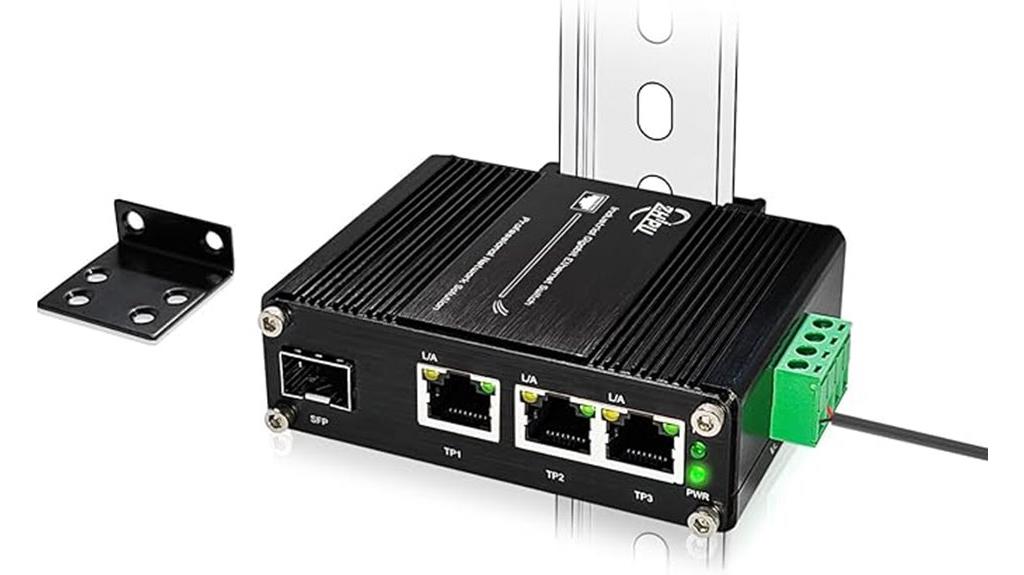
The Ports Mini Industrial Gigabit Ethernet Switch is an ideal choice for industrial environments that demand reliable, rugged networking solutions. It features three ports—RJ45 and SFP—supporting 10/100/1000 Mbps with auto-MDI/MDI-X, plus a 100/1000Base-X SFP port for flexible connectivity. Its compact aluminum design withstands extreme temperatures (-40°C to 75°C) and harsh conditions like dust and vibration. With unmanaged plug-and-play operation, it’s easy to install on DIN rails or walls, making it perfect for industrial, home, or office use. Redundant power inputs and energy-saving features guarantee stable, reliable performance, even in challenging environments.
Best For: industrial, home, and office environments requiring durable, reliable gigabit Ethernet connectivity with rugged, compact hardware.
Pros:
- Supports high-speed 10/100/1000 Mbps connections with auto-MDI/MDI-X for easy setup
- Rugged aluminum case withstands extreme temperatures and harsh conditions
- Dual power inputs and energy-saving features enhance reliability and efficiency
Cons:
- Limited management features, may require manual configuration for advanced options
- Firmware bugs and language issues can complicate troubleshooting
- Minimal documentation and lack of firmware updates hinder detailed support and maintenance
SFP Ethernet Fiber Optic Switch with 4 Optical Ports and 2 Electrical Ports

Designed for high-performance backbone networks, the SFP Ethernet Fiber Optic Switch with 4 optical ports and 2 electrical ports offers seamless data transmission over long distances. It supports up to 120 km fiber transmission, making it ideal for large-scale deployments. The switch features LED indicators for easy monitoring and supports jumbo frames of 9K bytes for efficient data handling. With multiple protocols and adaptive full/half duplex modes, it ensures reliable, lossless transfer. Compatibility with Gigabit SFP modules and auto-flip ports simplifies installation. Its rugged metal construction allows operation in diverse environments, providing a durable, high-speed backbone solution.
Best For: organizations requiring high-speed, long-distance backbone network connections in large-scale or enterprise environments.
Pros:
- Supports fiber transmission distances up to 120 km, ideal for extensive network deployments.
- Features LED indicators for real-time network monitoring and easy troubleshooting.
- Compatible with multiple protocols and auto-flip ports for flexible, plug-and-play installation.
Cons:
- Metal construction, while durable, may be heavier and less suitable for portable setups.
- Requires SFP modules for optical ports, which could add to initial setup costs.
- Operating temperature range of 0°C to 60°C may limit use in extreme environments.
PNGKNYOCN SC APC Fiber Optical Splitter
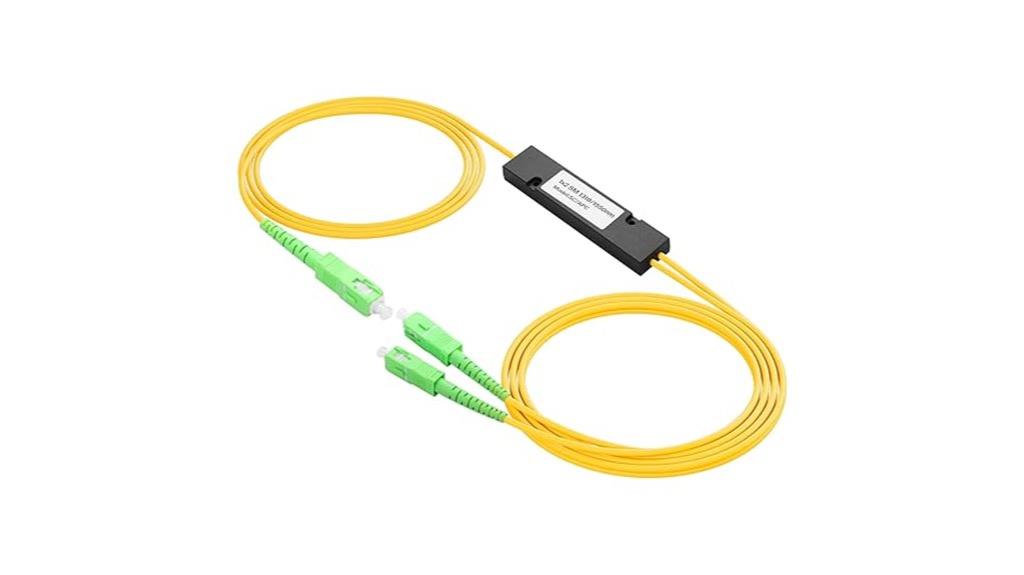
The PNGKNYOCN SC APC Fiber Optical Splitter stands out as an ideal choice for telecommunication providers and data centers that demand precise signal distribution in high-density environments. It efficiently splits light into two paths with high stability, ensuring even signal flow across networks. Compatible with all standard fiber optic devices, it operates within 1310nm to 1550nm wavelengths, featuring low insertion loss and high return loss for reliable performance. Its durable construction, including ceramic ferrules and impact-resistant casing, guarantees long-lasting, low-loss transmission. Its plug-and-play design simplifies installation, making it perfect for high-speed, stable connections in complex network setups.
Best For: telecommunication providers, data centers, and network installers needing reliable, high-density fiber optic signal distribution.
Pros:
- Ensures even and stable signal splitting with high stability and low insertion loss
- Durable construction with ceramic ferrules and impact-resistant casing for long-lasting performance
- Easy to install with plug-and-play design suitable for complex network environments
Cons:
- Limited to a 2-meter cable length per side, which may require additional cable management
- Compatibility limited to standard fiber optic connectors and devices within specified wavelength ranges
- May not be suitable for applications requiring more than two splitting paths
VFLTOOL 6 Duplex LC Fiber Patch Panel with 12 Ports

Are you looking for a compact, high-density fiber patch panel that simplifies rack organization and speeds up maintenance? The VFLTOOL 6 Duplex LC Fiber Patch Panel with 12 ports is an excellent choice. It features six duplex LC adapters, supporting both singlemode and multimode fibers, and is compatible with data rates up to 10Gbps. Made from durable steel with corrosion-resistant coating, it’s built for long-term use. Its tool-less, snap-in design allows quick installation, reducing setup and downtime. Perfect for data centers, LANs, and backbone networks, it ensures reliable, high-performance connections while maximizing rack space efficiency.
Best For: organizations seeking a compact, high-density fiber patch panel for quick, reliable, and organized network connections in data centers, LANs, and backbone networks.
Pros:
- Easy to install with a tool-less, snap-in design, saving time and effort
- Supports both singlemode and multimode fibers at data rates up to 10Gbps, ensuring versatility
- Durable construction with corrosion-resistant steel and ceramic inserts for long-term, high-performance use
Cons:
- Limited to 6 duplex LC adapters, which may not suffice for extremely large-scale deployments
- Plastic bodies, while lightweight, might be less impact-resistant compared to all-metal panels
- Compatibility is specific to LGX footprint racks, potentially requiring additional adapters for different rack systems
XMSJSIY SC Simplex Fiber Optical Wall Plate Panel Mount Coupler (2PCS)
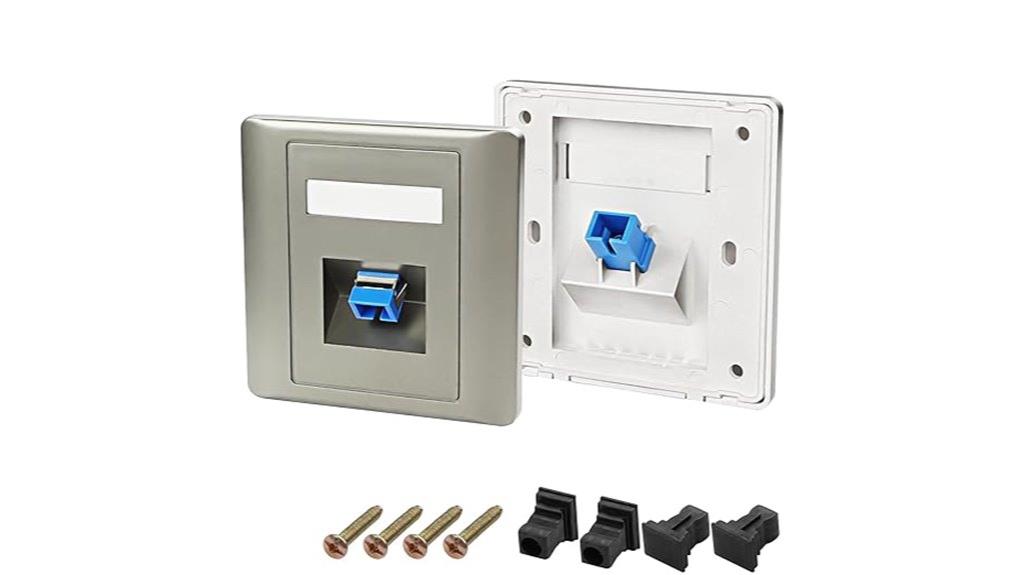
If you need a reliable way to extend fiber optic connections seamlessly within indoor environments, the XMSJSIY SC Simplex Fiber Optical Wall Plate Panel Mount Coupler is an excellent choice. This set includes two grey units that connect two fiber optic cables via a discreet wall-mounted panel. The SC to SC couplers feature dust caps that protect against dirt and maintain low signal loss. Made from durable, anti-aging PC material, they support long-term use and resist shocks. Ideal for telecom, LAN, and security setups, these wall plates ensure stable, clean connections with quick, wiring-free installation, making them perfect for indoor fiber optic networks.
Best For: Professionals and technicians seeking a durable, reliable solution for seamless indoor fiber optic connections in telecommunications, LAN, and security systems.
Pros:
- Easy quick-installation with a wiring-free, straight-in interface.
- Durable construction from high-quality PC material for long-term use.
- Protects connections with dust caps, ensuring minimal signal loss and cleanliness.
Cons:
- Designed primarily for indoor use, limiting outdoor application.
- May require technical knowledge for proper installation.
- Limited to simplex fiber connections, not suitable for multimode or more complex setups.
GESD 2PCS 6 Duplex 12 Core LC Adapters for Fiber Patch Panels
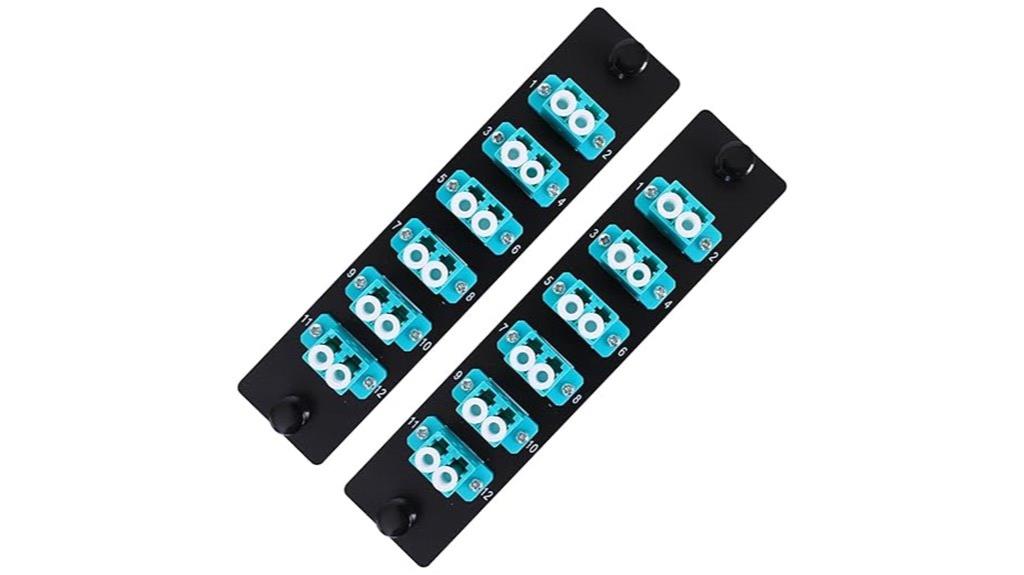
Looking for a reliable solution to maximize fiber patch panel density without sacrificing performance? The GESD 2PCS 6 Duplex 12 Core LC Adapters are perfect for high-density environments. Made with robust steel and a black electrostatic powder coating, they’re built for durability. These adapters support multimode and singlemode fibers, with ceramic ferrules for low insertion loss and high return loss. Their compact, rack-mountable design includes pre-installed clips and dust caps for quick, tool-less installation and protection. They’re compatible with various fiber types and standards, making them ideal for data centers, telecom, and enterprise networks seeking secure, high-speed connectivity with long-term reliability.
Best For: high-density data centers, telecommunications providers, and enterprise network installations seeking durable, high-performance fiber patch panel solutions.
Pros:
- Robust steel construction with electrostatic powder coating ensures durability and long-term use
- Supports both multimode and singlemode fibers with ceramic ferrules for optimal low insertion loss and high return loss
- Easy, tool-less installation with pre-installed clips and dust caps enhances efficiency and protection
Cons:
- May be less suitable for low-density or small-scale networking setups
- Requires rack-mounting space and appropriate infrastructure for deployment
- Compatibility is limited to LC adapters; not compatible with other connector types without adapters
XMSJSIY LC to LC Fiber Optic Adapter 2-Pack

The XMSJSIY LC to LC Fiber Optic Adapter 2-Pack is an ideal choice for network professionals seeking quick and secure fiber connections. These couplers are designed for wall plates, patch panels, and equipment cabinets, offering easy, plug-and-play installation. Made from durable zinc alloy, they resist high and low temperatures, corrosion, and wear. The adapters include protective sleeve caps for secure, low-loss connections, supporting stable, high-quality network transmission. Perfect for data centers, Ethernet, fiber optic CATV, and testing environments, they extend fiber jumpers effortlessly. Their compatibility with various mounting options makes them versatile for both local and wide-area networks.
Best For: network professionals and IT technicians who need reliable, quick, and secure fiber optic connections for data centers, LANs, and testing environments.
Pros:
- Easy plug-and-play installation for quick setup
- Durable zinc alloy shell resists corrosion and temperature variations
- Includes protective caps to ensure low signal loss and secure connections
Cons:
- Designed specifically for LC to LC connections, limiting versatility with other fiber types
- May require additional mounting accessories for certain setups
- Not suitable for outdoor or harsh environmental conditions without extra protection
Thumbstick Compatible with Ayn Odin 2 and Retroid Pocket 4

Designed specifically for Ayn Odin 2 and Retroid Pocket 4 handheld consoles, these thumbsticks offer a seamless fit and precise control that gamers need for ideal performance. The complete set includes two standard-height and two taller sticks, catering to different gaming preferences. Made from durable PETG, they resist wear and maintain their shape even after hundreds of hours. The translucent black design with RGB lighting adds a stylish touch. Easy to install, these thumbsticks instantly upgrade your gaming experience, providing better grip, responsiveness, and control for fast-paced FPS or action games. They’re a reliable choice for players seeking durability and enhanced precision.
Best For: gamers using Ayn Odin 2 or Retroid Pocket 4 seeking durable, precise thumbsticks with customizable height options for improved control and extended gameplay comfort.
Pros:
- Compatible specifically with Ayn Odin 2 and Retroid Pocket 4 for a perfect fit
- Made from durable PETG material that resists wear and maintains shape over time
- Includes both standard and taller sticks for customizable gaming precision and comfort
Cons:
- Limited to specific console models, not suitable for other handhelds
- Installation may require some basic technical skill for optimal fit
- Translucent black design with RGB lighting may not match all aesthetic preferences
QIANRENON Optical Fibre Splice Kit (2 Pcs)
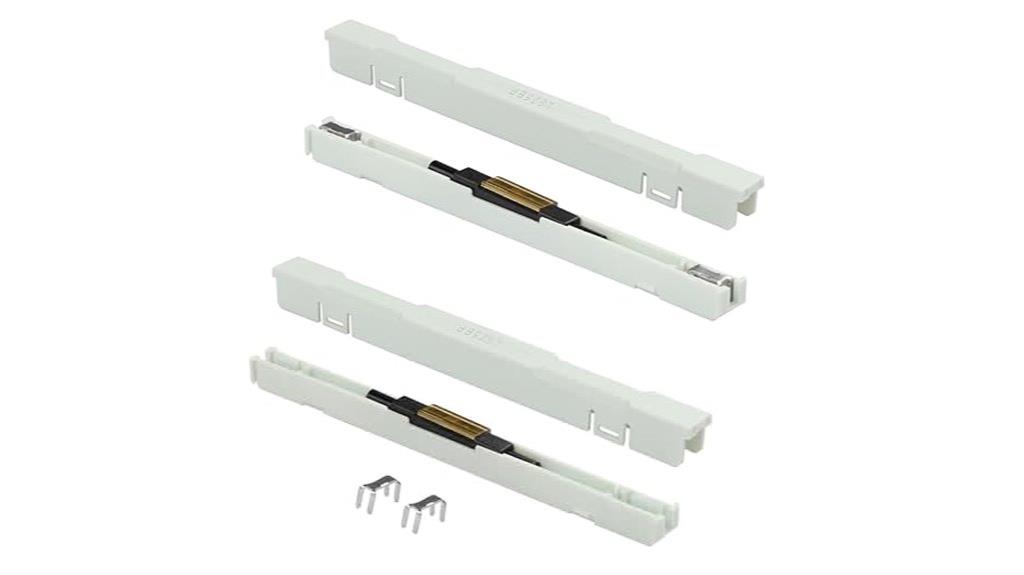
If you’re repairing or extending singlemode or multimode optical fibers in controlled environments, the QIANRENON Optical Fibre Splice Kit (2 Pcs) offers a cost-effective and reusable solution. Designed for bare fiber cables with core sizes of 9/125μm, 50/125μm, or 62.5/125μm, it fits cables with outer diameters up to 2mm. The cold splice connector provides stable performance with low insertion loss (≤0.10dB) and high return loss (≤-40dB). Easy to install, it features a fiber guide and protective cover. Ideal for lab settings, it’s a practical choice for quick, affordable repairs, but may be less suitable for field conditions with high signal loss.
Best For: DIY technicians and professionals performing cost-effective, quick repairs or extensions of bare singlemode or multimode optical fibers in controlled environments like labs.
Pros:
- Reusable and low-cost, reducing overall splicing expenses
- Easy to install with a fiber guide mechanism, suitable for quick setups
- Provides stable performance with low insertion loss and high return loss
Cons:
- May experience significant light loss (> -40dB), limiting use in high-precision applications
- Less effective in field conditions with environmental challenges or high signal degradation
- Not suitable for applications requiring minimal signal loss or highly reliable connections
Factors to Consider When Choosing a Fiber Optic Switch for Backbone
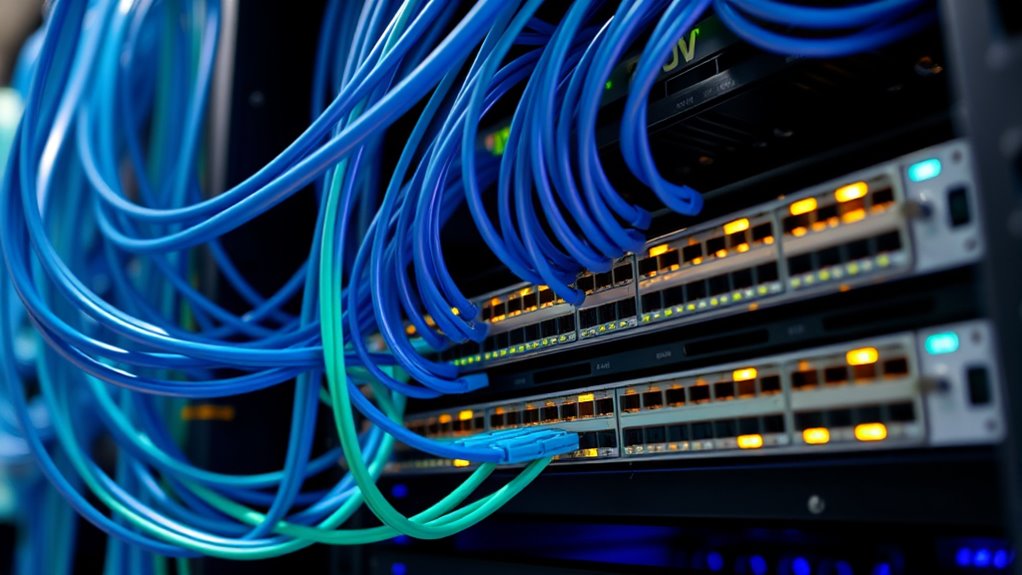
When selecting a fiber optic switch for your backbone network, I focus on several key factors to guarantee optimal performance. You need to contemplate how well it integrates with your existing infrastructure, along with transmission distance, speed, and durability standards. Additionally, features like power redundancy and management capabilities can make a significant difference in reliability and ease of use.
Compatibility With Existing Network
Ensuring compatibility with your existing network is essential when selecting a fiber optic switch for the backbone. First, check that the switch supports the same fiber types—singlemode or multimode—as your current setup to avoid issues down the line. Next, verify that its connector types, like SC, LC, or ST, match what’s already in place, preventing costly replacements. Wavelength compatibility is also important; the switch should align with your network’s optical transmission specs for seamless operation. Additionally, confirm it supports the same networking standards—such as Ethernet or Fiber Channel—to guarantee interoperability. Finally, make sure the switch’s support for cable lengths and transmission distances fits your physical network layout. Compatibility in these areas guarantees smooth integration and reliable performance.
Transmission Distance and Speed
Choosing the right fiber optic switch involves more than just compatibility; it also depends heavily on the transmission distance and speed your network needs. I look for switches that support the maximum transmission distance required—ranging from a few hundred meters to over 120 kilometers with the right SFP modules. Speed is equally important; I guarantee the switch can handle data transfer rates like 1Gbps, 10Gbps, or higher, matching my network’s demands. Full-duplex operation is essential to maximize throughput and reduce latency over longer distances. I also verify compatibility with different fiber types, such as single-mode or multi-mode, to optimize performance. In conclusion, I check if the switch’s ports support auto-negotiation and auto-detection, ensuring seamless connectivity at the desired speeds and distances.
Environmental Durability Standards
Selecting a fiber optic switch for backbone networks requires careful attention to environmental durability standards, as these devices often operate in demanding conditions. I look for switches with IP ratings like IP40 or IP67, ensuring protection against dust, water, and impacts. Operating temperature ranges from -40°C to 75°C or higher are essential for reliable performance outdoors or in industrial settings. I also check for resistance to electromagnetic interference (EMI) and lightning strikes, supported by surge protection and 6KV lightning protection. Rugged enclosures made of aluminum alloy or high-strength plastics help withstand physical stresses, corrosion, and temperature fluctuations. Certifications such as IEC 61000-4-5 for surge immunity and RoHS compliance confirm adherence to durability and safety standards. These factors ensure the switch’s longevity and reliable operation in harsh environments.
Power Supply and Redundancy
Have you considered how essential reliable power is for fiber optic switches in backbone networks? Ensuring continuous operation requires dual power inputs with automatic failover, so if one supply fails, the switch keeps running seamlessly. Redundant power supplies are vital for maintaining network stability, especially in critical infrastructure. Support for wide input voltage ranges, like 12V to 48V DC, offers flexibility across various industrial environments. Lightning protection and surge suppression enhance resilience against electrical disturbances, reducing downtime risks. Additionally, integrating uninterruptible power supplies (UPS) can provide backup power, ensuring network connectivity remains uninterrupted during outages. Prioritizing these power supply features helps create a more reliable, stable backbone network that minimizes downtime and maximizes performance.
Management and Configuration Features
Reliable power supplies keep fiber optic switches running smoothly, but managing and configuring these devices is equally important for maintaining a resilient backbone network. Managed switches offer advanced options like VLANs and QoS, allowing me to optimize traffic flow and prioritize critical data. Features like SNMP support, CLI access, and port management enable remote monitoring and troubleshooting, which is crucial for minimizing downtime. Firmware upgrade options help ensure security patches and new features are easily applied, keeping the network current. Redundant power supplies and failover configurations further enhance resilience, reducing the risk of outages. When selecting a switch, I consider these management features essential for flexible, secure, and reliable network operation—especially in complex backbone environments where uptime and performance are critical.
Frequently Asked Questions
What Are the Key Differences Between Managed and Unmanaged Fiber Optic Switches?
Managed fiber optic switches give me control over my network, allowing configuration, monitoring, and troubleshooting to optimize performance. Unmanaged switches, on the other hand, are plug-and-play, requiring no setup and offering limited control. I choose managed switches for complex networks needing customization and oversight, while unmanaged ones work well for simple setups where ease and quick deployment matter most.
How Does Port Speed Impact Backbone Network Performance in 2025?
Port speed is vital for backbone network performance in 2025. Faster speeds mean data flows seamlessly, reducing bottlenecks and delays that can cripple network efficiency. Imagine a highway where traffic moves smoothly—higher port speeds make that possible, ensuring quick data transfer across your entire infrastructure. As network demands grow, investing in higher port speeds becomes essential to keep up with increasing data loads and maintain reliable connectivity.
What Compatibility Considerations Are Essential for Fiber Switches in Existing Infrastructure?
When choosing fiber switches, I check compatibility with my existing infrastructure. I guarantee the switches support the same fiber types, like single-mode or multi-mode, and match the connector types we use. I also verify that their protocols and management features integrate smoothly with my current network setup. Compatibility is key to avoiding costly upgrades or disruptions, so I always double-check specs and vendor support before making a switch.
How Do Environmental Factors Influence Fiber Switch Deployment in Industrial Settings?
Environmental factors play a vital role in deploying fiber switches industrially. I always consider temperature extremes, humidity, dust, and vibration, as these can affect performance and longevity. For harsh settings, I opt for rugged, weatherproof enclosures that protect against contaminants and physical shocks. Proper planning guarantees reliable operation, minimizes downtime, and extends equipment lifespan, making environmental resilience a top priority when integrating fiber switches into tough industrial environments.
What Future Trends Are Shaping Fiber Optic Switch Technology in Backbone Networks?
Future trends in fiber optic switch technology include increased adoption of AI for smarter network management, higher data transfer speeds with advanced modulation techniques, and improved energy efficiency. I see more integration of virtualization to simplify network scalability and maintenance. As demand for reliable backbone connectivity grows, manufacturers are focusing on compact designs and enhanced security features. These innovations will make networks faster, more secure, and easier to manage.
Conclusion
When choosing a fiber optic switch for your backbone network, I know it can feel overwhelming—like finding a needle in a haystack. But with the right pick, you’ll experience connectivity so reliable, it’s practically unstoppable. These top options are the game-changers you need to keep your network blazing ahead without a hitch. Trust me, investing in the perfect switch will transform your network from good to legendary in no time!
